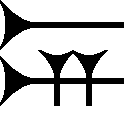Ni (cuneiform)
The cuneiform sign ni, is a common-use sign of the Amarna letters, the Epic of Gilgamesh, and other cuneiform texts. It has a secondary sub-use in the Amarna letters for addressing the Pharaoh, from the vassal states of Canaan. The address to the Pharaoh is often 'King-Lord-Mine': LUGAL, EN-ia which has many varieties of expression. "LUGAL" is Akkadian language for "Šarru", English "king", and EN in Akkadian is bēlu,[1] for "Lord", (thus "King, Lord-Mine"). In some Amarna letters the sub-use of ni is lí, for spelling "bēlu", be-lí often ![]()
![]()

(digitized form ni)
A common Amarna letter that uses cuneiform ni.
| Wikimedia Commons has media related to Ni (cuneiform). |
There are other sub-uses of ni (see Epic of Gilgamesh usage below). It is also found in some Amarna letters, EA 9, and EA 252, for example where ni or lí is scribed in a "flourish" format (an over-lengthened version of the 2-horizontals that construct the sign), similar to tab, ![]()
Epic of Gilgamesh usage
The ni sign usage in the Epic of Gilgamesh is as follows: lí-(5) times, né-(42), ni-(326), ṣal-(8), zal-(1), Ì-(9) times. Ì, the Sumerogram is Akkadian language "šamnu", for English "oil".[2]
Because of its multiple usages in the Epic, ni, or lí, can be used as a syllabic for " "ne", "ni", or "li"/"lí", etc. It also can be used as a syllabic for combinations related to: "sal", "ṣal", or "zal"; (in Akkadian many consonants, or the 4-vowels, a, e, i, u can be interchanged, for performing the final Akkadian language 'dictionary word').
References
- Parpola, 197l. The Standard Babylonian Epic of Gilgamesh, Glossary, pp. 119-145, bēlu, šarru, p. 122, p. 141.
- Parpola, 197l. The Standard Babylonian Epic of Gilgamesh, Sign List, pp. 155-165, no. 231, p. 159.
- Moran, William L. 1987, 1992. The Amarna Letters. Johns Hopkins University Press, 1987, 1992. 393 pages.(softcover, ISBN 0-8018-6715-0)
- Parpola, 197l. The Standard Babylonian Epic of Gilgamesh, Parpola, Simo, Neo-Assyrian Text Corpus Project, c 1997, Tablet I thru Tablet XII, Index of Names, Sign List, and Glossary-(pp. 119–145), 165 pages.